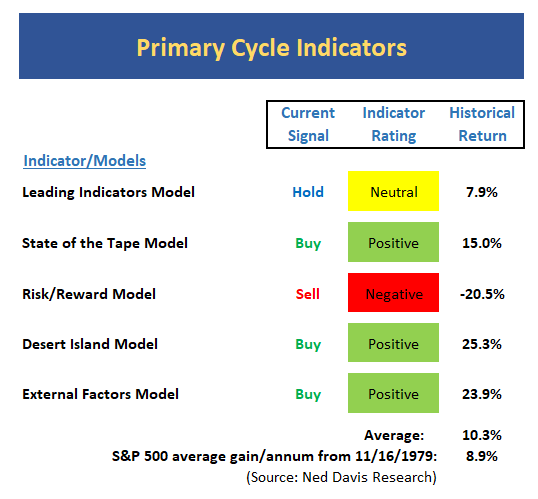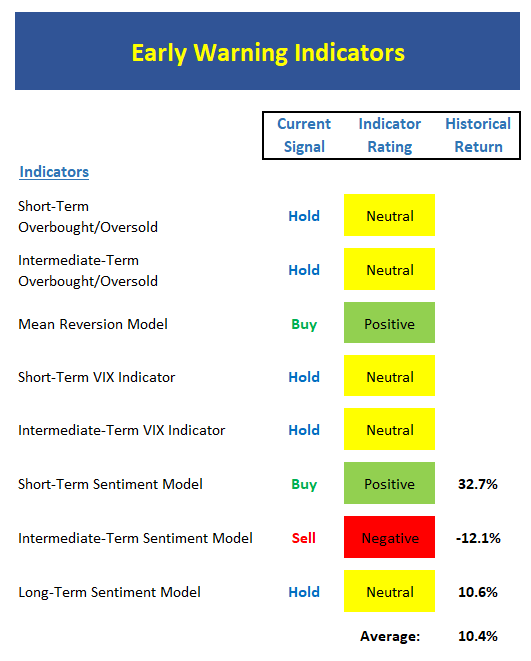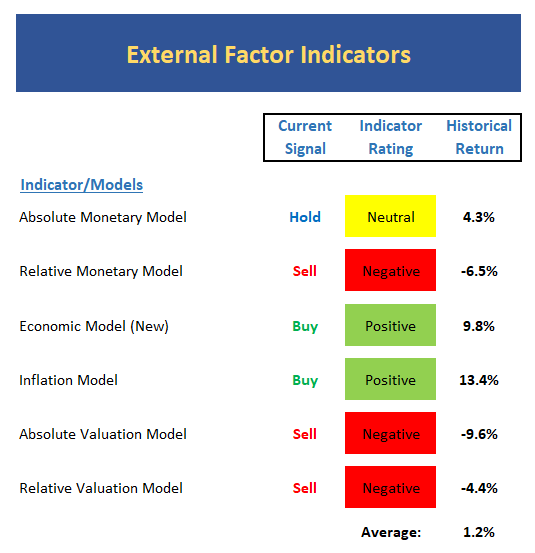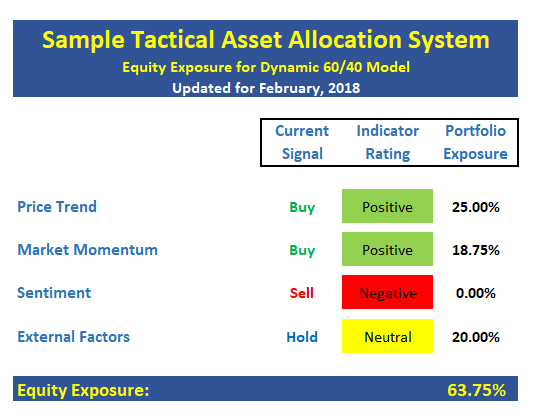Has The Storm Passed?
Although we can ever know for sure why Ms. Market does what she does, I believe last week's price action may have been telling.
Recall that I've opined a time or two lately that the vicious decline which unfolded from January 29 through February 9 was partly fundamental and partly technical. And the good news is it looks like the worst of the technical aspect of the decline may have run its course.
The Fundamental/Macro Picture
To review, the fundamental part of the equation is tied to inflation, interest rates and Fed policy expectations. Personally, I felt that the uber-violent decline of 10% was unlikely driven solely by the fundamental picture. This view is due primarily to my belief that the macro inflation worries were largely tied to forecasts and not to actual data.
To be fair though, I will argue that the rise in interest rates can be attributed to data as the U.S. Treasury's plans for bond sales, which are slated to be more than double last year's total, was enough to cause selling in the bond pits.
And now that we've seen the CPI/PPI data, which contained arguments for both teams, I continue to believe that a swift "reset" of macro expectations wasn't a justifiable "excuse" for a 10% correction in stock prices.
Yes, inflation has accelerated over the last few months. Yes, the year-over-year data is above the Fed's target. And yes, we do have a new Fed Chairman, who may or may not want to change course in the coming year.
However, we need to keep in mind that the big driver of inflation is wage growth. And the bottom line is that while wages are improving, the word "overheating" really is not part of the discussion here.
So, from my seat, I contend that the fundamental/macro factors in play could certainly cause stocks to pull back a bit or experience a period of "sloppy" action for a few months. Especially in a market that was extremely overbought and over-believed. But a 10% dive over five days? Uh, I don't think so.
The Technical Picture
This brings us to what I'm calling the "technical" aspect of the market's dance to the downside.
I promise not to rehash the gory details of the algorithmic trading, the spike in the VIX, the unwind of the short-vol trade, the systematic volatility targeting strategy moves, the breaking of the short-vol products, and the forced selling that ensued from what amounted to a perfect storm for the bears.
The bottom line on the technical front is all of the above were involved. And in my humble opinion, THIS is where one should lay the majority of the responsibility for the market's plunge. THIS is what causes the venerable Dow Jones Industrial Average to lose more than 1,000 points twice in a single week. And THIS is what was behind the Dow's back-to-back 850+ point moves down and then up over the span of minutes in a single session.
This is also what the term "market structure" is all about. Cutting to the chase, there are no market-makers standing by ready to buy/sell a round lot of the stock they represent at any moment in time anymore. No, market-makers have been replaced by computers, which have a nasty tendency to "pull bids" when the going gets tough and when, in reality, the market needs a "real" bid the most.
It is during times of market crisis that bids disappear completely and anyone looking to sell is greeted by a vacuum. In short, it is this "structure" that creates the environment where flash crashes can and will continue to thrive in.
The Message
Although the market environment can change in a heartbeat, my takeaway from last week's action is that the technical picture has definitely improved. This suggests that the bottom is in and that the "perfect storm" that created the extreme volatility has passed.
This does NOT mean that volatility will dwindle going forward and/or return to last year's levels. This does not mean that the stock market will skip the "retest" phase. And this does not mean that stocks will run back to the old highs in a straight line.
However, at this stage of the game, it appears that the extreme violence phase may be complete and that trading may return to a more rational mode. Fingers crossed!
Thought For The Day:
Happiness is in the heart, not in the circumstances. - Author Unknown
Wishing you green screens and all the best for a great day,

David D. Moenning
Founder, Chief Investment Officer
Heritage Capital Research
HCR Focuses on a Risk-Managed Approach to Investing
Must Read: What Risk Management Can and Cannot Do
HCR's Financial Advisor Services
HCR's Individual Investor Services
Questions, comments, or ideas? Contact Us
At the time of publication, Mr. Moenning held long positions in the following securities mentioned: None - Note that positions may change at any time.
The State of the Big-Picture Market Models
It's a new week, so let's start things off with a review of the state of my favorite big-picture market models, which are designed to tell us which team is in control of the prevailing major trend.

View My Favorite Market Models Online
Executive Summary:
- The Leading Indicators model, which is long-term oriented, remains on a long-term buy signal, but the indicator level itself has pulled back to neutral this week.
- *** NEW SIGNAL *** Perhaps the most important change on any of the indicator boards this week is the REVERSAL of the sell signal produced by the State of the Tape Model last week. While the level of the model is not robust, this is a positive development.
- *** NEW SIGNAL *** The second biggest change this week is the Risk/Reward model slipped into negative territory and produced a sell signal.
- My "desert island" model, which is a combination of trend, momentum, and external factors, remains on a long-term buy signal and the model reading is back in the positive zone this week.
- The newly expanded External Factors model is solidly positive again this week. This suggests that the cyclical bull trend remains intact.
The State of the Trend
Digging into the details, I like to start my weekly review with a look at the "state of the trend." These indicators are designed to give us a feel for the overall health of the current short- and intermediate-term trend models.

View Trend Indicator Board Online
Executive Summary:
- After six straight advances, the short-term Trend Model is back to positive.
- The short-term Channel Breakout system remains negative to start the week. However an advance past Friday's intraday high would flip this indicator positive.
- The intermediate-term Trend Model is neutral at this point.
- The intermediate-term Channel Breakout System flashed remains on its 2/5 sell signal and is currently a long way from a buy.
- The long-term Trend Model remains positive. As I said last week, this is an indication that what we are seeing now is a correction and not a bear market.
- The Cycle Composite turns remains green this week.
- From an intermediate-term perspective, the market remains in a mean-reverting mode.
- Technicians suggest that last week's rally was the "bounce" phase of the waterfall decline playbook and that the "retest" is up next.
The State of Internal Momentum
Next up are the momentum indicators, which are designed to tell us whether there is any "oomph" behind the current trend.

View Momentum Indicator Board Online
Executive Summary:
- The short-term Trend and Breadth Confirm Model improved to neutral last week.
- The Industry Health Model improved a bit last week but remains in the neutral zone.
- The short-term Volume Relationship model flipped back to positive last week but only by a small margin.
- The intermediate-term Volume Relationship Model remains in good shape and on a buy signal.
- The Price Thrust Indicator has improved but remains in negative territory to start the week.
- The Volume Thrust Indicator improved to neutral last week but has yet to flash a fresh buy signal.
- The Breadth Thrust Indicator also improved last week
- The bottom line for the momentum board is that while the market internals have improved, we have not seen any "thrust" buy signals that would represent an "all clear" alert.
The State of the "Trade"
We also focus each week on the "early warning" board, which is designed to indicate when traders might start to "go the other way" -- for a trade.

View Early Warning Indicator Board Online
Executive Summary:
- From a near-term perspective, stocks are neither overbought or oversold.
- From an intermediate-term view, stocks have reversed the extreme overbought condition and move briefly into an oversold condition. However, neither team has the wind at their back to start the week here.
- The Mean Reversion Model issued a buy signal last week and is now positive.
- The short-term VIX indicator remains in never-land from a signal standpoint. However, the most recent signal was a buy.
- This intermediate-term VIX signal remains on a buy signal as the indicator works off the extreme volatility signal produced at the beginning of the decline.
- From a short-term perspective, market sentiment reached the extreme negative zone and has now reversed. As such, a buy signal has been given.
- The intermediate-term Sentiment Model briefly improved last week but starts this week back in the red zone.
- The Longer-term Sentiment model has reversed from an all-time high reading in terms of optimism and starts the week just inside the neutral zone.
The State of the Macro Picture
Now let's move on to the market's "external factors" - the indicators designed to tell us the state of the big-picture market drivers including monetary conditions, the economy, inflation, and valuations.

View External Factors Indicator Board Online
Executive Summary:
- The Absolute Monetary model remains just barely neutral but is within a whisker of a sell signal.
- The Relative Monetary Model slipped into negative territory last week and issued a sell signal.
- No change on the economic model front. The Economic Model continues to suggest a strong economic environment and decent equity returns.
- The Inflation Model remains positive however, the model has turned, which is the first sign that inflationary pressures may be starting to rise.
- The Absolute Valuation Model reading spiked to a new high reading for the current cycle and is moving in the wrong direction for the bulls.
- Our Relative Valuation Model (which incorporates the current level of interest rates) flashed a timely sell signal at he beginning of the month and remains negative.
Sample Tactical Allocation Model
Below is an EXAMPLE (and ONLY an EXAMPLE) of how one might incorporate the indicator boards. The approach shown below is designed to provide the current equity allocation for a balanced tactical asset allocation model with a base target of 60/40 stocks/bonds.
The overall intent of the model is to keep equity exposure in line with current conditions.
Beginning February 2018, the model will be updated monthly.

The model above is for illustrative and informational purposes only and does not in any way represent any investment recommendation. The model is merely a sample of how indicators can be grouped to create a guide to market exposure based on the inputs from multiple indicators/models.
Indicators Explained
Short-Term Trend-and-Breadth Signal Explained: History shows the most reliable market moves tend to occur when the breadth indices are in gear with the major market averages. When the breadth measures diverge, investors should take note that a trend reversal may be at hand. This indicator incorporates NDR's All-Cap Dollar Weighted Equity Series and A/D Line. From 1998, when the A/D line is above its 5-day smoothing and the All-Cap Equal Weighted Equity Series is above its 25-day smoothing, the equity index has gained at a rate of +32.5% per year. When one of the indicators is above its smoothing, the equity index has gained at a rate of +13.3% per year. And when both are below, the equity index has lost +23.6% per year.
Channel Breakout System Explained: The short-term and intermediate-term Channel Breakout Systems are modified versions of the Donchian Channel indicator. According to Wikipedia, "The Donchian channel is an indicator used in market trading developed by Richard Donchian. It is formed by taking the highest high and the lowest low of the last n periods. The area between the high and the low is the channel for the period chosen."
Intermediate-Term Trend-and-Breadth Signal Explained: This indicator incorporates NDR's All-Cap Dollar Weighted Equity Series and A/D Line. From 1998, when the A/D line is above its 45-day smoothing and the All-Cap Equal Weighted Equity Series is above its 45-day smoothing, the equity index has gained at a rate of +17.6% per year. When one of the indicators is above its smoothing, the equity index has gained at a rate of +6.5% per year. And when both are below, the equity index has lost -1.3% per year.
Industry Health Model Explained: Designed to provide a reading on the technical health of the overall market, Big Mo Tape takes the technical temperature of more than 100 industry sectors each week. Looking back to early 1980, when the model is rated as "positive," the S&P has averaged returns in excess of 23% per year. When the model carries a "neutral" reading, the S&P has returned over 11% per year. But when the model is rated "negative," stocks fall by more than -13% a year on average.
Cycle Composite Projections: The cycle composite combines the 1-year Seasonal, 4-year Presidential, and 10-year Decennial cycles. The indicator reading shown uses the cycle projection for the upcoming week.
Trading Mode Indicator: This indicator attempts to identify whether the current trading environment is "trending" or "mean reverting." The indicator takes the composite reading of the Efficiency Ratio, the Average Correlation Coefficient, and Trend Strength models.
Volume Relationship Models: These models review the relationship between "supply" and "demand" volume over the short- and intermediate-term time frames.
Price Thrust Model Explained: This indicator measures the 3-day rate of change of the Value Line Composite relative to the standard deviation of the 30-day average. When the Value Line's 3-day rate of change have moved above 0.5 standard deviation of the 30-day average ROC, a "thrust" occurs and since 2000, the Value Line Composite has gained ground at a rate of +20.6% per year. When the indicator is below 0.5 standard deviation of the 30-day, the Value Line has lost ground at a rate of -10.0% per year. And when neutral, the Value Line has gained at a rate of +5.9% per year.
Volume Thrust Model Explained: This indicator uses NASDAQ volume data to indicate bullish and bearish conditions for the NASDAQ Composite Index. The indicator plots the ratio of the 10-day total of NASDAQ daily advancing volume (i.e., the total volume traded in stocks which rose in price each day) to the 10-day total of daily declining volume (volume traded in stocks which fell each day). This ratio indicates when advancing stocks are attracting the majority of the volume (readings above 1.0) and when declining stocks are seeing the heaviest trading (readings below 1.0). This indicator thus supports the case that a rising market supported by heavier volume in the advancing issues tends to be the most bullish condition, while a declining market with downside volume dominating confirms bearish conditions. When in a positive mode, the NASDAQ Composite has gained at a rate of +38.3% per year, When neutral, the NASDAQ has gained at a rate of +13.3% per year. And when negative, the NASDAQ has lost at a rate of -8.5% per year.
Breadth Thrust Model Explained: This indicator uses the number of NASDAQ-listed stocks advancing and declining to indicate bullish or bearish breadth conditions for the NASDAQ Composite. The indicator plots the ratio of the 10-day total of the number of stocks rising on the NASDAQ each day to the 10-day total of the number of stocks declining each day. Using 10-day totals smooths the random daily fluctuations and gives indications on an intermediate-term basis. As expected, the NASDAQ Composite performs much better when the 10-day A/D ratio is high (strong breadth) and worse when the indicator is in its lower mode (weak breadth). The most bullish conditions for the NASDAQ when the 10-day A/D indicator is not only high, but has recently posted an extreme high reading and thus indicated a thrust of upside momentum. Bearish conditions are confirmed when the indicator is low and has recently signaled a downside breadth thrust. In positive mode, the NASDAQ has gained at a rate of +22.1% per year since 1981. In a neutral mode, the NASDAQ has gained at a rate of +14.5% per year. And when in a negative mode, the NASDAQ has lost at a rate of -6.4% per year.
Short-Term Overbought/sold Indicator: This indicator is the current reading of the 14,1,3 stochastic oscillator. When the oscillator is above 80 and the %K is above the %D, the indicator gives an overbought reading. Conversely, when the oscillator is below 20 and %K is below its %D, the indicator is oversold.
Intermediate-Term Overbought/sold Indicator: This indicator is a 40-day RSI reading. When above 57.5, the indicator is considered overbought and when below 45 it is oversold.
Mean Reversion Model: This is a diffusion model consisting of five indicators that can produce buy and sell signals based on overbought/sold conditions.
VIX Indicator: This indicator looks at the current reading of the VIX relative to standard deviation bands. When the indicator reaches an extreme reading in either direction, it is an indication that a market trend could reverse in the near-term.
Short-Term Sentiment Indicator: This is a model-of-models composed of 18 independent sentiment indicators designed to indicate when market sentiment has reached an extreme from a short-term perspective. Historical analysis indicates that the stock market's best gains come after an environment has become extremely negative from a sentiment standpoint. Conversely, when sentiment becomes extremely positive, market returns have been subpar.
Intermediate-Term Sentiment Indicator: This is a model-of-models composed of 7 independent sentiment indicators designed to indicate when market sentiment has reached an extreme from an intermediate-term perspective. Historical analysis indicates that the stock market's best gains come after an environment has become extremely negative from a sentiment standpoint. Conversely, when sentiment becomes extremely positive, market returns have been subpar.
Long-Term Sentiment Indicator: This is a model-of-models composed of 6 independent sentiment indicators designed to indicate when market sentiment has reached an extreme from a long-term perspective. Historical analysis indicates that the stock market's best gains come after an environment has become extremely negative from a sentiment standpoint. Conversely, when sentiment becomes extremely positive, market returns have been subpar.
Absolute Monetary Model Explained: The popular cliché, "Don't fight the Fed" is really a testament to the profound impact that interest rates and Fed policy have on the market. It is a proven fact that monetary conditions are one of the most powerful influences on the direction of stock prices. The Absolute Monetary Model looks at the current level of interest rates relative to historical levels and Fed policy.
Relative Monetary Model Explained: The "relative" monetary model looks at monetary indicators relative to recent levels as well as rates of change and Fed Policy.
Economic Model Explained: During the middle of bull and bear markets, understanding the overall health of the economy and how it impacts the stock market is one of the few truly logical aspects of the stock market. When our Economic model sports a "positive" reading, history (beginning in 1965) shows that stocks enjoy returns in excess of 21% per year. Yet, when the model's reading falls into the "negative" zone, the S&P has lost nearly -25% per year. However, it is vital to understand that there are times when good economic news is actually bad for stocks and vice versa. Thus, the Economic model can help investors stay in tune with where we are in the overall economic cycle.
Inflation Model Explained: They say that "the tape tells all." However, one of the best "big picture" indicators of what the market is expected to do next is inflation. Simply put, since 1962, when the model indicates that inflationary pressures are strong, stocks have lost ground. Yet, when inflationary pressures are low, the S&P 500 has gained ground at a rate in excess of 13%. The bottom line is inflation is one of the primary drivers of stock market returns.
Valuation Model Explained: If you want to get analysts really riled up, you need only to begin a discussion of market valuation. While the question of whether stocks are overvalued or undervalued appears to be a simple one, the subject is extremely complex. To simplify the subject dramatically, investors must first determine if they should focus on relative valuation (which include the current level of interest rates) or absolute valuation measures (the more traditional readings of Price/Earnings, Price/Dividend, and Price/Book Value). We believe that it is important to recognize that environments change. And as such, the market's focus and corresponding view of valuations are likely to change as well. Thus, we depend on our Valuation Models to help us keep our eye on the ball.
Disclosures
The opinions and forecasts expressed herein are those of Mr. David Moenning and may not actually come to pass. Mr. Moenning's opinions and viewpoints regarding the future of the markets should not be construed as recommendations. The analysis and information in this report is for informational purposes only. No part of the material presented in this report is intended as an investment recommendation or investment advice. Neither the information nor any opinion expressed constitutes a solicitation to purchase or sell securities or any investment program.
Any investment decisions must in all cases be made by the reader or by his or her investment adviser. Do NOT ever purchase any security without doing sufficient research. There is no guarantee that the investment objectives outlined will actually come to pass. All opinions expressed herein are subject to change without notice. Neither the editor, employees, nor any of their affiliates shall have any liability for any loss sustained by anyone who has relied on the information provided.
Mr. Moenning may at times have positions in the securities referred to and may make purchases or sales of these securities while publications are in circulation. Positions may change at any time.
The analysis provided is based on both technical and fundamental research and is provided "as is" without warranty of any kind, either expressed or implied. Although the information contained is derived from sources which are believed to be reliable, they cannot be guaranteed.
Investments in equities carry an inherent element of risk including the potential for significant loss of principal. Past performance is not an indication of future results.
